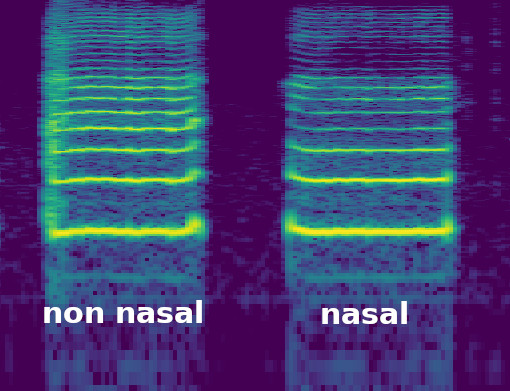This site is under construction! Stuff be missing, beware! Contribute!
If you have additions, corrections or concerns, open an issue or contact a maintainer.
Voice Map is released! See here for a giant map of (almost) all voice characteristics and pedagogy!Table of contents
Nasality
When a voice has too much air going through the nasal passage when speaking, we call it hypernasality or just nasality.
Nasality darkens the voice by making formants less highlighted.

Non-nasal:
Nasal:
Hypernasality
This is when the voice lets air through the nose even when it’s not doing nasal sounds like N, M, NG. This makes the voice “dull” because some of the resonance features of it are now missing.
Testing Hypernasality
The main method of checking for nasality is to say a non nasal phrase (one without any N or M or NG sounds) without and then with the nose pinched. If there’s a difference, there is nasality. The degree of nasality is how “honky” the sound is when we pinch the nose. We can then reduce the honky-ness intuitively or use other methods.
Non Nasal Phrases
- Pick up the crate, be careful of the glass.
- Would you please take these three glasses to be washed below the tap.
- That black cat attacked the plastic bag.
- The elevator stopped for us at the third floor.
Exercises
Practice nasality and check it
- say a ?non-nasal phrase
- e.g. “pick up the crate but be careful of the glass”
- pinch your nose and say it again
- the amount it is different by is how much hypernasality is in the voice
- you can try to breathe through the nose or mouth to force it to be nasal or non-nasal as well
- breathing out through the mouth and trying to hum at the same time is a good way to get nasality
- a breathy sigh through the mouth can help getting non-nasal
- get used to the difference in sound and feeling between the two and notice it as much as possible
- notice the dull or muted quality of nasality and the brighter more open quality of non-nasal voice
- practice making it more nasal and then less, both in normal voice and in the pinched nose state
Hyponasality
Hyponasality is when the voice cannot go through the nose. We can test that by saying a non-nasal phrase and then a nasal one. If it sounds like the nose is blocked in the nasal passage, we have some form of hyponasality. This can also come with hyp*ernasality; it can be that we’re letting air through the nose when we shouldn’t, but then also the nose is blocking that air, so that all of the voice is honky / blocked.
Nasal Phrases
- my momma makes lemon jam
Testing hyponasality
- say a non-nasal phrase
- say a nasal phrase
- if only the nasal phrase sounds honky, we have hyponasality
- if both sound honky, we have hyponasality and hypernasality simultaneously